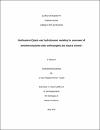Northeastern Qatari coast hydrodynamic modeling for assessment of sensitive ecosystems under anthropogenic and natural stressors
| Advisor | Bin Hamadou, Radhouan |
| Author | Yousuf, Ruqaiya Ammar |
| Available date | 2015-12-06T08:07:30Z |
| Publication Date | 2015-05 |
| Abstract | The Northeastern Qatari coast, comprising diverse and sensitive flora and fauna communities (e.g. coral reefs and patches, seagrass meadows and turtles) is expected to undergo changes imposed by anthropogenic stressors (coastal development projects) in the near future. Therefore, the need to study the impacts of such scenarios on the existing ecosystems is pressing. Ecohydrological models are theoretical, mathematical representations of a natural system, made to understand the functionalities of the real ecological system under physical forcing. Using gathered data from sites, ecological associations are inferred and then combined to build a functional ecosystem model that mimics the real environment. These model systems are then used in order to assist the impact assessment of future scenarios on real systems. The aim of this study was to create hydrodynamic simulation along with a sediment transport model for a stretch of coastline off of Jabal Fuwairat. This aim was achieved using GEMSS modeler software, which requires the following data for a proper model (1) spatial data (that is included as shape files imported from ArcGIS), primarily the water body shoreline and bathymetry, additionally the locations, altitudes, and formations of man-made structures; (2) time-based data, that are varying in time (i.e. tidal changes, influx rate and temperature and meteorological data) and (3) Sediment composition. These data were collected and gathered into time varying data files that are loaded into a control file. A hydrodynamic model (HDM) simulating the spatial dynamics of the water was developed, calibrated and validated using field data. Additionally, a sediment transport model (STM) identifying, under present or simulated scenarios, the fate of the suspended sediment in the region and identifying potentially erosion and sedimentation area in the studied coastal zone is proposed. This STM assimilates data about sediment typologies, suspended particulate matter and currents near the seafloor (shear stress). Results from both HDM and STM models demonstrated that the study area is highly dynamic, being mainly controlled by tides and with relatively high shear stress (potential for erosion) in the northern and east-western boundaries. Considering these factors, the present research work intends to understand through a modeling approach the ecohydrological features of this area with special emphasis on the sediment dynamics and potential risks facing the sensitive coral reefs located in the area. This work provides three scenarios of future development that might take place in the area and shows the alteration of the dynamics of water and sediments accordingly. These simulations help the development of recommendations to decision makers for a better management of the considered coastal zone. It also provides a tool that can be replicated in future hydrodynamic studies along the Qatari coastal zone. |
| Language | en |
| Subject | Hydrodynamic model Sediment transport model Anthropogenic stressors coastal dynamics GEMSS |
| Type | Master Thesis |
| Alternative Abstract | من المتوقع أن يخضع الساحل الشمالي الشرقي القطري في المستقبل القريب لتغييرات التي تفرضها الضغوطات البشرية )مشاريع التنمية الساحلية( . يتألف هذا الساحل من النباتات المتنوعة والحيوانات حساسة )مثل الشعاب المرجانية ، ومروج الأعشاب البحرية والسلاحف ( لذلك هناك حاجة ملحة إلى دراسة الآثار المترتبة على مثل هذه الثغيرات على النظم الإيكولوجية. النماذج الإيكولوجية ، هي عبارة عن تمثيلات رياضية و نظرية للنظام الطبيعي، التي أدخلت على فهم الخصائص الوظيفية للنظام البيئي الحقيقي تحت تاثيرات فيزيائية معروفة تمثل النظام المدروس . باستخدام البيانات التي تم جمعها من حقول او من الجمعيات البيئية لبناء نموذج النظام البيئي الوظيفي الذي يحاكي البيئة الحقيقية . ثم يتم استخدام هذه النظم كنموذج من أجل مساعدة تقييم تأثير السيناريوهات المستقبلية على الأنظمة الحقيقية . الهدف من هذه الدراسة هو خلق المحاكاة الهيدروديناميكية جنبا إلى جنب مع نموذج نقل الرواسب لتمتد من الساحل قبالة جبل فويرط . وقد تحقق هذا الهدف باستخدام برنامج GEMSS لصناعة النماذج، و الذي يتطلب البيانات التالية للحصول على نموذج السليم 1( البيانات الفضائيه ) كملفات من نظام ( ArcGIS (، الذي يتضمن الخط الساحلي للمنطقة وقياس الأعماق، بالإضافة إلى المواقع، الارتفاعات، و تشكيلات الهياكل التي من صنع الإنسان . . (2) البيانات التي تستند على الوقت، والتي هي متفاوتة في الوقت المناسب )أي تغيرات المد والجزر، ومعدل التدفق ودرجة الحرارة وبيانات الأرصاد الجوية( . (3) تكوين الرواسب. تم صنع النموذج الهيدروديناميكي لمحاكاة ميكانيكيات المياة والتحقق من صحة البيانات بمقارنتها مع بيانات حقليه . بالإضافة إلى ذلك, تم صنع نموذج نقل الرواسب الذي يحدد مصير الرواسب العالقة في المنطقة وتحديد أحتمل حدوث التعرية اوالترسيب في اي منطقة اخرى . أظهرت النتائج لكل من النموذج الهيدروديناميكي والنموذج نقل الرواسب أن منطقة الدراسة هي منطقة ديناميكية للغاية، يتم التحكم بها بشكل رئيسي من قبل المد والجزر وأن احتمال التعريه للرواسب تتزايد في الحدود الشمالية والشرق والغرب . يوفر هذا العمل ثلاثة سيناريوهات للتنميه المستقبلية التي قد تحدث في هذه المنطقة، ويظهر تغيير ديناميكيات المياه والرواسب وفقا لذلك . وفقا لذلك خرجنا بمجموعة من التوصيات لصناع القرار لتحسين إدارة المنطقة الساحلية . كما أنه يوفر الأدوات التي يمكن تكرارها في الدراسات الهيدروديناميكية في المستقبل على طول المنطقة الساحلية القطرية . |
| Department | Biological and Environmental Sciences |
Files in this item
This item appears in the following Collection(s)
-
Biological & Environmental Sciences [102 items ]



